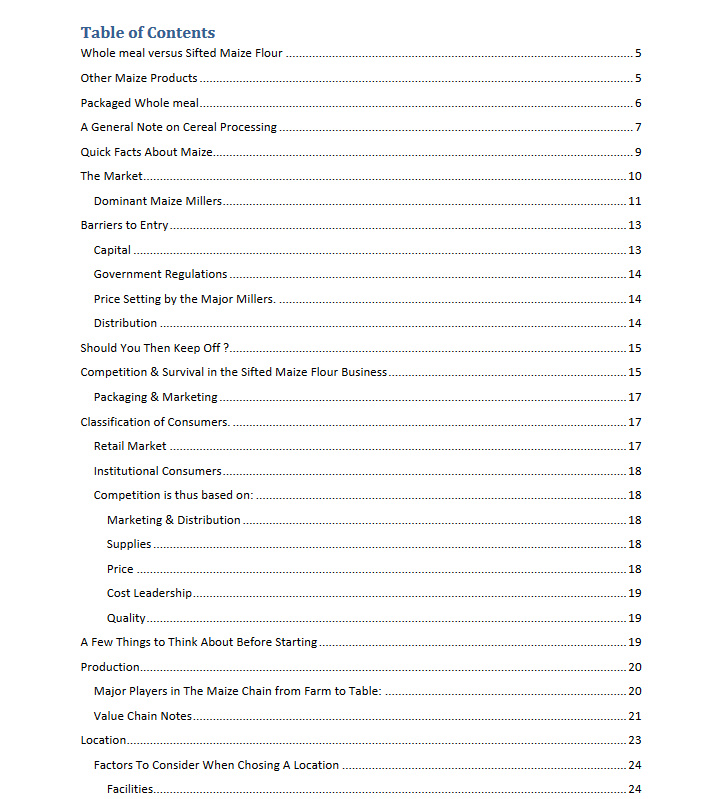Sifted Maize Flour Business Plan
Sifted Maize Flour Business Plan

Sifted Maize Flour Business Plan Overview
This Sifted Maize Flour Business Plan will help you as you set a small commercial sifted maize flour processing mill. The core final product of the processing will be Grade 1 sifted maize flour. This is as opposed to whole meal flour.
Whole maize meal flour – often referred to as Grade 2 – is produced from milling the whole grain.Sifted maize flour such as Jogoo, Soko, Shujaa , Pembe and such others are produced by milling maize after removing both the husk and germ.
In Kenya 3 types of maize flour are available in the market:
- Whole Meal – Produced in Posho Mills
- Partly Sifted Flour – Produced in Posho Mills by partly removing the germ and bran
- Sifted Maize Mill – Produced by fully removing the germ and bran usually by commercial millers
Other Maize Products
In addition to flour maize can be processed into its constituent chemical components in a technical practice known as wet milling. End products of this could be ethanol and starches which are used in the food and paper industry for making adhesives, sweets and other confectionery.
Eldoret based Corn Products was the leading wet milling company in Kenya. The plant, established in 1973, was part of 54 wet processing units operated by a US based company. The firm largely produced starch and glucose which it sold to companies like Unga Limited and East Africa Breweries Limited (EABL).
Unfortunately in July 2012 the company shut down its manufacturing plant citing the uncompetitive maize prices in Kenya and inability to compete with imports. The plant had a capacity to process 2000 bags of maize every day.
Due to competition from millers the company at times had to purchase maize at retail prices, making the end products costly when compared to imported alternatives. However the firm still maintains a sales office in Nairobi which imports starches from units in other countries for sale locally. Maize can be also processed to different types of grits that are used for brewing, making breakfast cereals and other snacks.
Maize processing in Kenya is still in its infancy and limited. Githeri and ugali are the main ways Kenyans consume maize. But there are hundreds of ways to consume maize. In a country like Mexico they have over 300 ways which they use to consume maize from tortillas to tamales. On the face of it there is thus opportunity to introduce more methods of processing and consuming maize.
The challenge is of course is how you introduce a new food to consumers who have been stuck in particular ways for ages. This does not mean it can’t be done. It can done with proper research and strategy.
With changing health preferences and an increasing number of consumers moving towards healthy natural foods some entrepreneurs have toyed with the idea of packaging whole meal flour targeting the ‘middle class’.
Download Sifted Maize Flour Business Plan / guide here